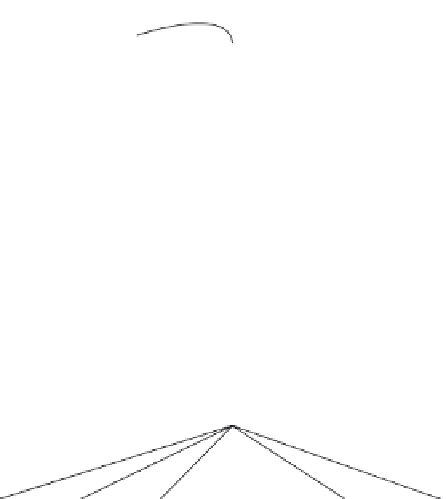Agriculture Reference
In-Depth Information
Phenylalanine
PA L
Cinnamic acid
C4H
p
-Coumaric acid
4CL
Phenyl propanoid
pathway
p
-Coumaryl CoA
CHS
Flavonoid pathway
Acetyl-CoA
Malonyl-CoA
Chalcone
CHI
Flavanone (naringenin)
F3H
Dihydroflavonol
DFR
Leucoanthocyanidin
ANS
UFGT
Glycosylated
anthocyanindins
Anthocyanidin
Anthocyanin
Petunidin Pelargonidin
Fig. 21.2
A simplified presentation of anthocyanin biosynthesis in plants. PAL, phenylalanine ammonia lyase;
C4H, cinnamate-4-hyroxylase; 4CL, 4-coumaryl CoA ligase; CHS, chalcone synthase; CHI, chalcone isomerase;
F3H, flavanone-3-hydroxylase; DFR, dihydroflavonol-4-reductase; ANS, anthocyanin synthase; UFGT, UDP-
glucose flavonoid 3-oxy-glucosyltransferase. (Adapted from Jaakola et al., 2002.)
Peonidin
Malvidin
Cyanindin
Delphinidin
Anthocyanins are synthesized through flavonoid biosynthetic pathway, which is shown
in Fig. 21.2. The first step of anthocyanin biosynthesis is the condensation of three molecules
of malonyl-CoA with
p
-coumaroyl-CoA in the presence of the enzyme CHS, which
produces chalcone. In the presence of chalcone isomerase, chalcone is converted to fla-
vanone (naringenin) (Jaakola et al., 2002). Flavanone is hydroxylated through flavanone-
3-hydroxylase (F3H) and forms dihydroflavonols, which differ in the number of hydroxyl
groups. Dihydroflavonol-4-reductase (DFR) transforms dihydroflavonols to colorless leu-
coanthocyanidin, which yields colored anthocyanidins in the presence of the enzyme an-
thocyanin synthase (ANS). The glycosylation of anthocyanidins leads to the formation of
anthocyanins by the enzyme UDP-glucose flavonoid 3-oxy-glucosyltransferase (UFGT).



































Search WWH ::

Custom Search